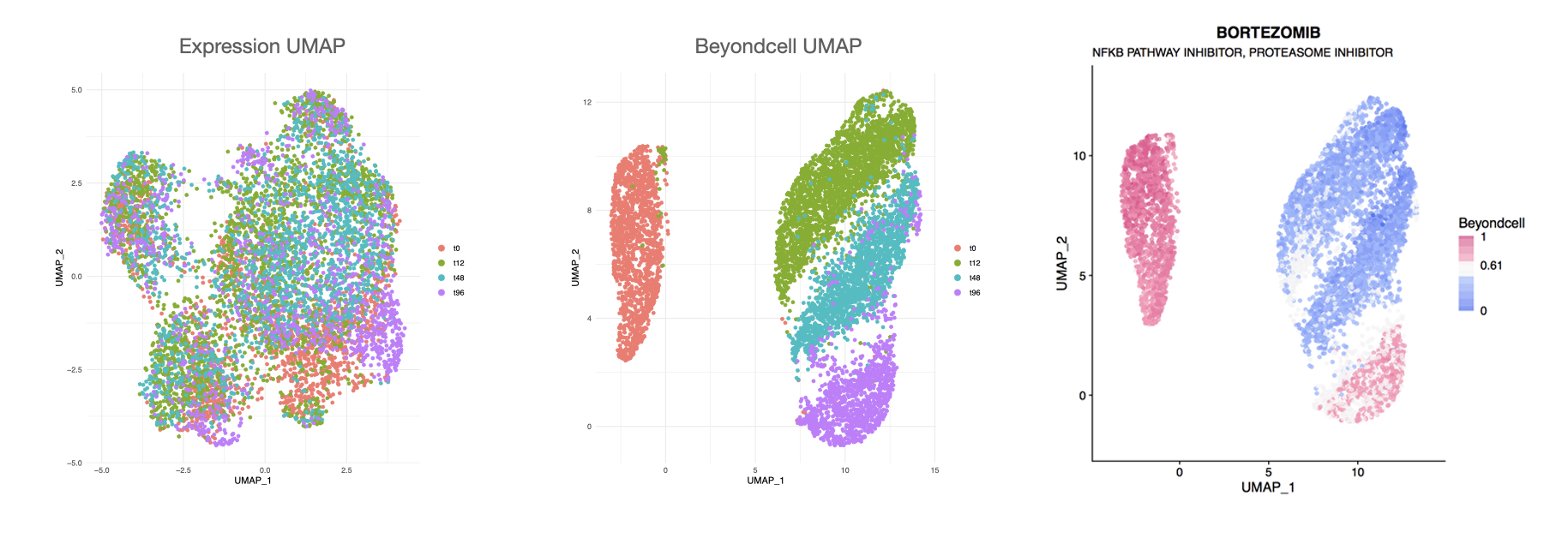News: Beyondcell 1.3.3 has been added to bioconda and from now on it will be updated exclusively in that channel.
Beyondcell is a methodology for the identification of drug vulnerabilities in single-cell RNA-seq (scRNA-seq) data. To this end, Beyondcell focuses on the analysis of drug-related commonalities between cells by classifying them into distinct Therapeutic Clusters (TCs).
Beyondcell workflow. Given two inputs, the scRNA-seq expression matrix and a collection of drug signatures, the methodology calculates a Beyondcell Score (BCS) for each drug-cell pair. The BCS ranges from 0 to 1 and measures the susceptibility of each cell to a given drug. The resulting BCS matrix can be used to determine the sample’s TCs. Furthermore, drugs are prioritized in a table and each individual drug score can be visualized in a UMAP.
Depending on the evaluated signatures, the BCS represents the cell perturbation susceptibility (PSc) or the sensitivity to the drug effect (SSc). BCS can also be estimated from functional signatures to evaluate each cell functional status.
- Analyse the intratumoural heterogeneity (ITH) of your experiment
- Classify your cells into TCs
- Prioritize cancer treatments
- If time points are available, identify the changes in drug tolerance
- Identify mechanisms of resistance
The Beyondcell algorithm is implemented in R (v. 4.0.0 or greater). We recommend running the installation via conda:
# Create a conda environment.
conda create -n beyondcell
# Activate the environment.
conda activate beyondcell
# Install mamba and downgrade python to 3.6 (in order to use umap-learn).
conda install -c conda-forge mamba=0.17.0
mamba install python=3.6
# Install Beyondcell package and dependencies.
mamba install -c bioconda r-beyondcellWe have validated Beyondcell in a population of MCF7-AA cells exposed to 500nM of bortezomib and collected at different time points: t0 (before treatment), t12, t48 and t96 (72h treatment followed by drug wash and 24h of recovery) obtained from Ben-David U, et al., Nature, 2018. We integrated all four conditions using the Seurat pipeline (left). After calculating the BCS for each cell using PSc, a clustering analysis was applied. Beyondcell was able to cluster the cells based on their treatment time point, to separate untreated cells from treated cells (center) and to recapitulate the changes arisen by the treatment with bortezomib (right).
For general instructions on running Beyondcell, check out the analysis workflow and visualization tutorials. For more information about how Beyondcell normalization works, please refer to this vignette.
- Coral Fustero-Torre
- María José Jiménez-Santos
- Santiago García-Martín
- Carlos Carretero-Puche
- Luis García-Jimeno
- Tomás Di Domenico
- Gonzalo Gómez-López
- Fátima Al-Shahrour
Fustero-Torre, C., Jiménez-Santos, M.J., García-Martín, S. et al. Beyondcell: targeting cancer therapeutic heterogeneity in single-cell RNA-seq data. Genome Med 13, 187 (2021). https://doi.org/10.1186/s13073-021-01001-x
If you have any question regarding the use of Beyondcell, feel free to submit an issue.



